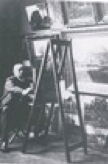Vincent regularly made trips to Eindhoven. He gave lessons to a couple of amateur painters in Anton Hermans' house, bought his paint at Baijens, his printing ink from the firm Gestel & Sons, and visited his friend Anton Kerssemakers who lived just opposite the former station. He even took piano lessons for a while, but turned out to have more of an eye for color than for the tones of sound.
All four of Van Gogh's students came from Eindhoven: Dimmen Gestel, Antoon Hermans, Anton Kerssemakers and Willem van de Wakker. Van Gogh taught them to be better painters. They were his friends and his most deserving amateur painters. The 'artists club' met together in the drawing school on the market place in Eindhoven.
Original artworks by these four artist friends are on display in our museum in Nuenen. This has been made possible by the Friends of Vincent van Gogh and Nuenen Foundation, in association with the Eindhoven Museum.

Anton Kerssemakers was born in Gestel (Eindhoven) on Aug. 28, 1846 and died in Eindhoven on July 6, 1924. He was by profession a leather tanner, saddle maker and tobacconist. Vincent and Anton met each other in November 1884 through a chance meeting with chemist and paint supplier Jantje Baijens.
Vincent had a study of the Genneper water mill with him at that time. Vincent had painted this work from the garden of the Rapelenburg house and despite the freezing temperatures, he had wanted to work outdoors. On his way home he would most likely have gone to Baijens, before going to the station to catch the train to Nuenen.
Baijens had to deliver some paint to Anton Kerssemakers who lived close to the station, so he suggested to Vincent that they walk together. On the way Baijens told him that Anton Kerssemakers was busy painting landscapes on the walls of his office instead of having them papered. He wondered if Vincent was interested in meeting him. Things really must have clicked between Anton and Vincent on that first occasion, because that same evening Kerssemakers painted a still life under Vincent's guidance. It is thought likely that Kerssemakers formed part of the 'artists club' which met in the drawing school on the Eindhoven market place and painted under Vincent's guidance.
Vincent's style and influence can be seen in the works of Kerssemakers.
 Willem van de Wakker was born in Almelo on April 17, 1859 and died in Nijmegen on April 30, 1927.
Willem van de Wakker was born in Almelo on April 17, 1859 and died in Nijmegen on April 30, 1927.
He worked as a telegraph operator in the telegraph office on the market place. This office, like the drawing school was housed in the Weighing House. Vincent saw some of Van de Wakker's works which had been sent to be framed at Baijens the chemist. "Send that man to me..." Vincent said to Jantje Baijens. And he did just that.
Van de Wakker's name appears on a postcard from Vincent to Anton Kerssemakers.
In an interview in 1927 Van de Wakker recalled some interesting anecdotes about the Potato Eaters painting: one evening, after a full day of painting, Vincent walked past the De Groot family house. He often painted there and went inside for a rest. The family were sitting together right under the lamp and had just started to eat. Vincent spontaneously took his canvas, brush and palette and began to paint the group.
 Antoon Hermans was born in Oss on December 17, 1822 and died in Roermond on August 29, 1897.
Antoon Hermans was born in Oss on December 17, 1822 and died in Roermond on August 29, 1897.
Hermans was wealthy, a former goldsmith, traveled widely and collected works of art and antiques. He was also a church warden at the Catharinakerk.
His friend, the architect Pierre Cuypers built an imposing house for him on the Keizersgracht. Vincent made designs of the four seasons for the dining room. Hermans then had to copy these paintings under Vincent's instructions.
Being an antique dealer, Hermans had a collection of objects that Vincent could borrow as a source of inspiration for his still lifes. Hermans liked to paint in an academic style and auctioned many of his framed paintings for the poor. The painting Cows in the landscape is one example of this.
 Dimmen Gestel was born in Dirksland on Aug. 31, 1862 and died in Eindhoven on June 30, 1945.
Dimmen Gestel was born in Dirksland on Aug. 31, 1862 and died in Eindhoven on June 30, 1945.
Dimmen Gestel was studying drawing at the National Academy in Amsterdam when he made Vincent's acquaintance. His father owned Gestel & Sons Lithographers in Eindhoven. Vincent sometimes bough printing ink here to make his paintings darker than he could with paint.
Vincent saw several of Dimmen's paintings at the printers and thought they showed promise. Vincent asked Dimmen's parents to send their son to Nuenen. And so he became Van Gogh's "student.
Dimmen painted, drew and produced prints of still lifes, but mostly of landscapes and Brabant interiors in the style of the Hague School. He also designed several posters.